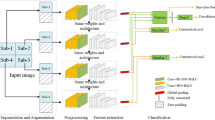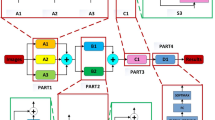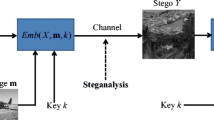Abstract
Deep convolutional networks bring new energy to image steganography. It is an opportunity for steganalysis research. However, the operations to widen the gap between covers and stegos are only in the preprocessing layers for most existing networks. In this paper, a residual steganalytic network (RestegNet) is proposed to overcome this limitation. We design a novel building block group, which consists of two alternating building blocks: 1) A sharpening block based on residual connections (ShRC), which makes the noise of steganography overwhelm the image content, and aims to enhance steganographic signal detectability. 2) A smoothing block based on residual connections (SmRC), which seeks to downsample the feature maps to boil them down to useful data. First, we use the same preprocessing layers as previous methods to ensure minimum performance. Then, we use these building block groups to exaggerate the traces of steganography further and make the difference between covers and stegos in the feature extraction layers. Contrastive experiments with previous methods conducted on the BOSSbase 1.01 demonstrate the effectiveness and the superior performance of the proposed network.









Similar content being viewed by others
References
Bas P, Filler T, Pevný T (2011) “break our steganographic system”: the ins and outs of organizing BOSS. In: Information hiding - 13th international conference, IH 2011, prague, Czech Republic, May 18-20, 2011, revised selected papers. Springer, pp 59–70
Chen M, Sedighi V, Boroumand M, Fridrich JJ (2017) Jpeg-phase-aware convolutional neural network for steganalysis of JPEG images. In: Proceedings of the 5th ACM workshop on information hiding and multimedia security, IH&MMSec 2017, Philadelphia, PA, USA, June 20-22, 2017. ACM, pp 75–84
Denemark T, Sedighi V, Holub V, Cogranne R, Fridrich JJ (2014) Selection-channel-aware rich model for steganalysis of digital images. In: 2014 IEEE International workshop on information forensics and security, WIFS 2014, Atlanta, GA, USA, December 3-5, 2014, pp 48–53
Fridrich JJ, Kodovský J (2012) Rich models for steganalysis of digital images. IEEE Trans Inf Forensic Secur 7(3):868–882
He K, Zhang X, Ren S, Sun J (2016) Deep residual learning for image recognition. In: 2016 IEEE conference on computer vision and pattern recognition, CVPR 2016, Las Vegas, NV, USA, June 27-30, 2016, pp 770–778
Holub V, Fridrich JJ, Denemark T (2014) Universal distortion function for steganography in an arbitrary domain. EURASIP J Inf Secur 2014(1):1
Huang G, Liu Z, Weinberger KQ (2016) Densely connected convolutional networks. CoRR arXiv:1608.06993
Li B, Wei W, Ferreira A, Tan S (2018) Rest-net: Diverse activation modules and parallel sub-nets based cnn for spatial image steganalysis. IEEE Signal Process Lett PP(99):1–1
Qian Y, Dong J, Wang W, Tan T (2015) Deep learning for steganalysis via convolutional neural networks. In: Proceedings of the international society for optics and photonics, media watermarking, security, and forensics 2015, San Francisco, CA, USA, February 9-11, 2015, p 94090J
Szegedy C, Liu W, Jia Y, Sermanet P, Reed SE, Anguelov D, Erhan D, Vanhoucke V, Rabinovich A (2015) Going deeper with convolutions. In: IEEE conference on computer vision and pattern recognition, CVPR 2015, Boston, MA, USA, June 7-12, 2015, pp 1–9
Tan S, Li B (2014) Stacked convolutional auto-encoders for steganalysis of digital images. In: Asia-pacific signal and information processing association annual summit and conference, APSIPA 2014, Chiang Mai, Thailand, December 9-12, 2014. IEEE, pp 1–4
Tang W, Li H, Luo W, Huang J (2014) Adaptive steganalysis against WOW embedding algorithm. In: ACM information hiding and multimedia security workshop, IH & MMSec ’14, Salzburg, Austria, June 11-13, 2014, pp 91–96
Xu G (2017) Deep convolutional neural network to detect J-UNIWARD. In: Proceedings of the 5th ACM workshop on information hiding and multimedia security, IH&MMSec 2017, Philadelphia, PA, USA, June 20-22, 2017. ACM, pp 67–73
Xu G, Wu H, Shi Y (2016) Structural design of convolutional neural networks for steganalysis. IEEE Signal Process Lett 23(5):708–712
Xu G, Wu H, Shi Y (2016) Ensemble of CNNs for steganalysis: an empirical study. In: Proceedings of the 4th ACM workshop on information hiding and multimedia security, IH&MMSec 2016, Vigo, Galicia, Spain, June 20-22, 2016. ACM, pp 103–107
Ye J, Ni J, Yi Y (2017) Deep learning hierarchical representations for image steganalysis. IEEE Trans Inf Forensic Secur 12(11):2545–2557
Yedroudj M, Comby F, Chaumont M (2018) Yedrouj-net: an efficient CNN for spatial steganalysis. CoRR arXiv:1803.00407
Yu C, Li J, Li X, Ren X, Gupta BB (2018) Four-image encryption scheme based on quaternion fresnel transform, chaos and computer generated hologram. Multimedia Tools Appl 77(4):4585–4608. https://doi.org/10.1007/s11042-017-4637-6
Zhang R, Zhu F, Liu J, Liu G (2018) Efficient feature learning and multi-size image steganalysis based on CNN. CoRR arXiv:1807.11428
Acknowledgments
This work was supported by NSFC under 61802393, U1736214, U1636102 and 61872356, National Key Technology R&D Program under 2016YFB0801003 and 2016QY15Z2500, and Project of Beijing Municipal Science & Technology Commission under Z181100002718001.
Author information
Authors and Affiliations
Corresponding author
Additional information
Publisher’s note
Springer Nature remains neutral with regard to jurisdictional claims in published maps and institutional affiliations.
Rights and permissions
About this article
Cite this article
You, W., Zhao, X., Ma, S. et al. RestegNet: a residual steganalytic network. Multimed Tools Appl 78, 22711–22725 (2019). https://doi.org/10.1007/s11042-019-7601-9
Received:
Revised:
Accepted:
Published:
Issue Date:
DOI: https://doi.org/10.1007/s11042-019-7601-9




